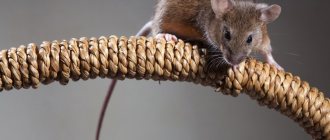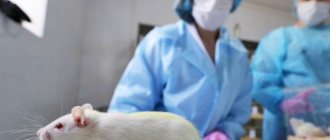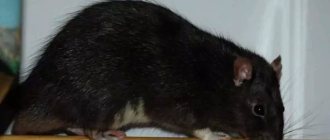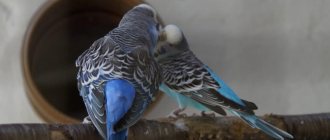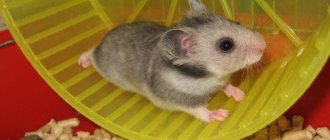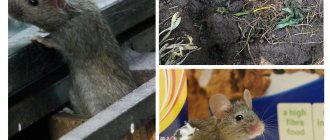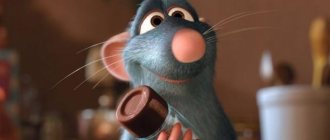Few people have been able to see baby mice, except perhaps those who breed these animals. But breeders claim that success in this fascinating activity is impossible without certain knowledge about the reproduction of rodents. Therefore, we will find out how many times a year a mouse can give birth without harm to health, how many cubs there are in one litter, and what kind of care they need.
What affects the reproduction of mice?
Both in the wild and in the home, several factors influence how mice reproduce. Among them:
- living conditions (temperature, humidity, presence of a permanent nest);
- access to food and adequate nutrition (a hungry female will find it difficult to bear and give birth to healthy offspring);
- health of the female and male.
- Om-Nom-nom
In addition, the weight of the parents also matters. In an emaciated mouse, the pregnancy will most likely end in premature birth or the birth of sick or dead mice. But an obese mouse can also have serious problems conceiving and bearing offspring.
What is the reason for such a large offspring?
One of the reasons why animals in the wild have large litters is due to the environment. Exposure to weather conditions and other factors can lead to high mortality among newborn pups.
Due to the lack of reliable and safe shelter or food, only the strongest survive. Under certain circumstances, females can eat their offspring. According to University of Oklahoma professor Douglas W. Mock, author of books and various publications, mothers can absorb baby mice for two reasons.
- Firstly, the female can leave the strongest ones, since she is not able to feed everyone. This avoids competition for food among those with greater potential.
- The calories gained from eating baby mice allow the mother to provide adequate nutrition for the remaining babies so that they too can produce offspring in the future.
For mice, as for many animals, one of the main instincts is the preservation of the species, and not the survival of a particular individual. And males try to make sure that it is their genes that are passed on to their offspring. If a rodent senses that the pups were born from another male, he can kill them. In this case, females can terminate pregnancy if a new male appears on their territory. In the wild, the lifespan of one individual is about one year, but inside the walls or foundation of your home they can live twice as long. Also worth noting: In the wild, mice's breeding seasons are spring and fall, but indoors they mate all year round! Thus, a pair of rodents has enormous potential for reproduction. One female can give birth to up to sixty mice per year. Remember also that with each litter the number of sama increases, and they are ready to reproduce after just six weeks. Unless you are intentionally breeding mice, this number of pests should come as a shock. Act quickly and get ahead of them.
Now that you have an idea of how two mice can create an entire army in a short time, you can appreciate the importance of traps and repellers. Victor® creates some of the best offerings on the market. When mouse intrusion goes undetected long enough, you need something that really works. Whether you prefer sticky, electronic or live traps, Victor® offers a variety of options to control multiple rodents at once.
>Features of reproduction and birth of mice
Puberty
Puberty in mice occurs quite early. The female's first estrus can begin as early as 5 weeks of age. A female can reproduce fully only after 2-3 months; before this time, the body is still developing and is not ready for the stresses that arise during pregnancy. Therefore, difficulties may arise both with bearing offspring and during childbirth.
The male is ready to mate after his testes descend into the scrotum. This usually occurs between 5 and 7 weeks of age. Under normal conditions and in the presence of sufficient food, the male retains the ability to reproduce almost until the end of his life.
How long do mice live?
Why are they doing that? There is only one goal: to understand the mechanism of aging and find a cure for eternal youth - man has always tried to cheat death in order to live forever! Perhaps getting long-lived mice is the first step towards your cherished dream.
So, in 2005, an unprecedented experiment was conducted at one of the research institutes, which ended in setting a record: their experimental pet managed to live for almost five years! Scientists are in no hurry to share the secrets of their stunning success, and all developments are kept in the strictest confidence.
In turn, Japanese scientists have proven that mice born from two mothers and without the father’s genes in their genetic code live a quarter longer than pets conceived in the traditional way. The experiment not only proves that reproduction is possible without the participation of males, but also makes it possible to see firsthand that male genes accelerate the aging process of the body.
There is a downside to this study:
- the experimental animals did not reach normal sizes - they were significantly smaller than ordinary pets;
- but their immune system was more active, and the animals were in better health.
The Japanese mouse is one of the varieties of the common house mouse. It is worth noting that in appearance and habits, representatives of this species are completely different from ordinary house rodents and are excellent as a pet.
Sexual cycle
The sexual cycle in mice lasts on average 5–7 days. This period includes 4 phases:
- precursor (proestrus) - this stage lasts approximately 48–60 hours, during which division of vaginal epithelial cells and keratinization of the upper layer occurs;
- estrus (estrus) – the period lasts 12–18 hours, at this time the upper layer of the epithelium is already keratinized, the female is completely ready for fertilization;
- post-estrus (metaestrus) – the duration of this phase is 24–30 hours;
- Interestrus (diestrus) – lasts about 5 days.
After mating, the female develops an inguinal plug - an additional layer of tissue that protects the mouse from re-fertilization by another male.
There is no estrus during lactation. It resumes 25–30 days after birth, 2–3 days after the female stops feeding the pups.
Attention! When a mouse is ready to breed, it becomes restless and may even show aggression. She takes a characteristic pose, slightly arching her back and raising her butt.
Selection, preparation, rules of use for future parents
Successful reproduction largely depends on the correct selection of a pair. All candidates are carefully assessed, analyzing:
- constitution and physique;
- fatness;
- quality of the fur coat;
- fertility if mice have already been bred.
Both the female and the male must be strong, outwardly healthy, well-fed, but not obese.
If the female has already given birth, then the best is considered the one that:
- was a wonderful mother;
- brought an average number of mice;
- had a high lactation rate.
Animals that have a history of eating their offspring or animals that suffer from excessive aggression should not be allowed into breeding.
The female can be used no more than twice during the year.
Frequent childbirth significantly undermines health, and an unrestored body is unlikely to be able to provide future offspring with everything necessary for full development. Thus, it was noticed that the cubs of females who had exhausted their strength were born weak, developed poorly and died prematurely.
Males are also used wisely: frequent mating depletes reproductive function and the mouse may simply remain unfertilized.
Before mating, animals are provided with complete feeding with a sufficient amount of vitamins (especially E) and microelements.
Obese rodents, which most often turn out to be temporarily infertile, are forced to move as much as possible, and foods rich in carbohydrates are excluded from their diet.
There should be no more than ten females per male. They can be kept all together, but it is better to place each animal in its own cage, placing the females with the male as needed at the time of estrus.
Pregnancy
During the first 7–10 days, it is impossible to determine pregnancy by visually examining the mouse; it looks the same as usual. The most obvious evidence of a female's pregnancy is the cessation of estrus. The behavior of rodents also changes - some females become calmer, while others, on the contrary, show irritability and aggressiveness. Gradually, the mouse’s appetite increases, it becomes less active, and begins to move more smoothly and carefully.
By the middle of the term, the mouse becomes rounder, its belly becomes larger, its nipples swell and become bright pink. The female begins to actively organize the nest - dragging sticks, hay, fluff, scraps of paper, small garbage.
Family
A fairly common problem in pregnant mice is toxicosis. It is manifested by loss of appetite, lethargy, increased salivation, and sometimes convulsions. The cause of this condition can be stress, poor nutrition, lack of fluids, and poor living conditions.
Pregnancy in wild and domestic mice proceeds almost identically. But most often, mice born at home are larger than their wild counterparts. This is due to the fact that pregnant mice in the wild eat worse and are also exposed to various stresses, while decorative mice spend their entire pregnancy in comfortable conditions, receiving a sufficient amount of nutritious, balanced food.
House conditions
In order to ensure a comfortable existence for your mouse, it is important for the owner to know how to keep mice. Mouse cage
Mouse cage
A metal cage is suitable as a permanent place of residence for a mouse, since the mouse can easily chew through plastic. The size of the cells is no more than a square centimeter, otherwise the animal will crawl through and run away.
Minimum dimensions of housing for a mouse: 30x30x40 centimeters.
The cage itself must be placed in a baking tray filled with sawdust. The bottom of the cage should also be sprinkled with dust or fine grass. The height of the layer should not exceed five centimeters.
There is no need to place the cage near strong heat sources - a heater or radiator. It should be placed where the temperature is always maintained.
There should also be a mouse nest inside the cage itself. A box with a round hole, a flower pot with a hole in the bottom, or something similar is suitable for this purpose. You can buy a house in a special store.
Physical activity is good for rodents
You also need to install a mouse running wheel inside the cage.
Constant physical activity will allow the animal to remain healthy.
Small plastic toys will not be superfluous, but you should not clutter the cage too much.
The cage needs to be cleaned from time to time.
Cleaning should not happen too often, but there is also no need to neglect this task for a long time. Once a month will be enough.
The mouse is very clean, but periodically you need to clean the cage
During cleaning, all items that were inside the cage must be removed and washed with hot water.
The cage should be mechanically cleaned with a cloth moistened with vinegar water.
It is important to understand that cleaning destroys all marks of the creature living inside, and such a strong influence with its frequency can lead to stress
Childbirth
Most often, mice give birth at night. Mice are born between midnight and 4 am. In rare cases, childbirth occurs in the evening between 16:00 and 20:00. Shortly before the start of labor, the female climbs into a pre-arranged nest. She does not need help, all actions are performed instinctively. The mouse takes the most comfortable position - most often it lies on its side, but it can also sit on the sacrum.
When labor begins and the first mouse appears, the female grabs it with her teeth and pulls it out. Then she gnaws through the membrane of the amniotic sac and gnaws the umbilical cord. After all the mice have appeared, the mouse carefully licks them and then eats the afterbirth.
Typically, if everything goes well, tiny mice are born every 5 minutes. If the delay is more than 15 minutes, then most likely the mouse is stuck, for example, due to its too large size. At home, a person helps a rodent in this situation; in nature, a mouse can die.
Kids
All mice give birth to one mouse at a time, but it is very difficult to say in advance how many there will be. How many pups a mouse gives birth to depends on the species and age of the female, and the number of births. Most often, a litter contains from 5 to 9 babies, but in general their number can vary from 1 to 15.
Newborn mice are naked, blind and deaf, their weight is about 1.5 g, and their size does not exceed 2 cm. Their skin is so thin that their insides can be seen through it.
Offspring
The health of the offspring depends on the quality of the female’s nutrition during pregnancy and the interval between matings. At birth, babies do not see or hear anything, they have no fur, but they have a good appetite. Each weighs no more than 1.5 g.
After a week, you can see grown hair on the animals’ bodies, and the first incisors of the lower jaw appear in the mouth. By 14 days of age, a baby mouse can already see and hear.
Females have noticeable nipples from childhood. In males, the testicles move from the abdominal cavity to the scrotum only in the second week. It is after this that the gender of the offspring can be understood.
A wild litter is not the same as that of a domestic mouse. It develops faster. If indoor rodents are picked up prematurely, the mother may abandon them.
Therefore, offspring can be accustomed to human attention after three weeks, when rodents leave the nest in search of new horizons.
Month-old indoor animals can be given to other people for new families. At this age, they are unlikely to eat their mother's milk. And they switch to adult food and become completely independent.
Video
The mouse has given birth! What to do ?
How often do mice breed?
Living in comfortable conditions and eating normally, mice can give birth 12–14 times during the year. In mice living in the wild, mating occurs uncontrollably, but cold weather makes its own adjustments and reproduction is temporarily suspended.
In the case of decorative mice, the process of reproduction and the number of matings is regulated by the owner of the rodents. To avoid health problems, females are mated no more than 3-4 times a year.
But mice that illegally live in a house or a warm basement mate constantly, and newborn mice appear all year round.
On a note! In a year, a female can give birth to from 70 to 150 cubs.
Cotton swab instead of a spoon
This decision was not easy. The mother already had a bad experience of feeding newborn mice. And I wasn’t at all attracted by the prospect of feeding them from a pipette every two hours... But there was nothing to do: three little lives depended on us.
In a warm house, the mice recovered and became more active. Unfortunately, we lost one of them almost immediately: either hypothermia affected him, or he was hit by a cultivator blade, but he died a few hours later. We fed the other two with a few drops of warm milk on a cotton swab (a pipette and a syringe without a needle are not suitable for this: they release the liquid in a stream that is too strong and the mouse can choke), and put them on a warm stove overnight.
So our mice lived for more than a day on the stove, from where I took them out to feed them.
When my husband and I were getting ready to go home, the mouse question came up sharply. On the one hand, I didn’t want to take them to the city (we both work, and it was not clear how to accommodate our schedule with their frequent feedings). But, on the other hand, my mother, who remained in the village, did not have any special formulas for feeding, and they were supposed to be needed in a couple of days. And I made up my mind: we took the mice home.
Development of little mice
Despite the fact that newborn mice are very tiny and can navigate only by smell, they have an excellent appetite. They immediately find the mother's nipple and begin to eat. Baby mice grow very quickly. Moreover, usually, regardless of the number of pups in the litter, they develop at the same pace, since weak individuals that have no chance of survival are eaten by the mother soon after birth. Approximate development schedule for newborn mice:
- on the 3-4th day the first fluff appears on the body;
- on days 4-5, the ears open and rise;
- on days 6-7, almost the entire body is covered with fur and the first teeth begin to cut;
- On days 12-13, the eyes open.
In the third week of life, the mice finally develop all motor functions, they can run and eat solid food. After only 3-4 weeks, the pups become independent and can do without their mother.
Description of the rodent
Animals of this species are very tiny compared to rats. The body of an adult mouse reaches only 6.5-9.5 cm in length. The tail of a rodent is almost half as long as the body. It is covered with scales and small sparse hairs.
The average weight of an adult is only 12 to 30 grams. The ears are small and rounded. The color is predominantly dark, brownish-gray. On the belly, the fur is lighter and colored ash-gray or white.
Are you afraid of mice?
Very Not a drop
Habitat
The most ancient remains of a mouse were found in Western Asia, North Africa and the northern regions of India.
Traveling with people on ships, mice quickly spread throughout the world and received the status of “cosmopolitan animal.”
Younger age
Starting from the fourth day, the development of little rat pups occurs at a rapid pace.
- 4th day the ears open, the pups begin to distinguish sounds and hear rustling sounds;
- 6th body is covered with soft dark fluff;
- On the 8th, teeth emerge, except for the main incisors.
After 10 days of life, the pups become active. They crawl well and master the terrain. If these are pets, they should be handled more often so that the animals grow up tame. However, during the game they should not be left unattended, since coordination of movements is not yet developed, the kids can fall to the floor from a table, any height.
Differences in behavior
If the pests were not caught red-handed, their presence can be determined by evidence. What is the difference between a mouse and a rat - the most important points.
Traces of a break-in
It is necessary to inspect the sites of sabotage. Rats are carnivores by nature. They prefer meat, lard, smoked meats, and carry bread, sausage, and cookies. They chew hard objects, preferring wood. They easily gnaw electrical wires and cords. They live near food waste and garbage cans.
Mice prefer grains, flour, sugar, cereals, and occasionally eat meat products. They leave behind damaged bags, plastic bags, newspapers, books, and leather goods. You can distinguish by these signs.
Footprints
They can freely talk about a pest that secretly hunts in the dark. The mouse leaves behind a chain of small steps located in close proximity to each other. The animal climbs well on shelves, window sills, cabinets, and rarely jumps. Mouse tracks in the snow are very clearly visible.
The rat moves with confident, long steps. If necessary, it can jump up to 1.5 m in height and up to 2 m in length. By this sign you can recognize the pest.
The footprints in the snow of a rat and a mouse are different: the former have round paw prints, while the rats have long ones.
On a note!
Rats rarely crawl into the house; they prefer outbuildings, cellars, warehouses, barns, sheds, and poultry houses. Don't mind eating chicken or gnawing on a pig's ears. Every farmer dreams of getting rid of rats in a chicken coop or barn. It can drag away a small puppy or kitten. If it enters a house, it usually hides under the floor. Mice love to live in human homes. They live in walls with insulation, under the floor, in the attic. At night you can often hear rustling sounds and the movement of small paws.
Interesting and educational facts about the life of rats
In India there is a Karni Mata temple where rats are revered, cared for and protected. If the rules for caring for a sacred animal and killing it are violated, this person is obliged to bring a golden figurine in the form of a rat to the temple.
In some American states, it is illegal to hit a rat with a baseball bat and can result in a $1,000 fine.
In Asian and African countries, rats are considered a worthy delicacy for a festive dinner. Rat meat is considered a delicacy.
A gray rat eats up to 12 kg of various cereal products per year. Experts have calculated that every year about 6 kg of one farmer’s harvest is spent on feeding one rat.
Sources
- https://notklop.ru/krysy/o-krysah/malenkie-krysyata/
- https://litbro.ru/gryzuny/mysh/mysh-malyutka
- https://litbro.ru/gryzuny/mysh/o-detenyshah-myshey
- https://1klop.com/chem-pohozha-i-otlichaetsya-myish-ot-kryisyi
- https://zelenyjmir.ru/krysa/
- https://litbro.ru/gryzuny/mysh/kak-otlichit-mysh-ot-krysy
- https://notklop.ru/krysy/o-krysah/krysy-i-myshi/
[collapse]
Behavior of adults
You can also distinguish mice from rats by their behavior. The mouse is very afraid of people and does not catch their eye, and in case of any threat it tries to run away very quickly. Pasyuki, on the contrary, are very angry and aggressive, and sometimes even attack people. And large individuals sometimes even gather in flocks and fight off enemies together.
Pasyuki do not get along with voles and are not in the same house or outbuildings with them at the same time. If they have already appeared, this means that all other small animals will be destroyed or move to another place.
